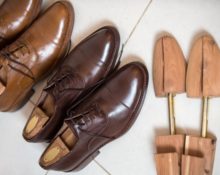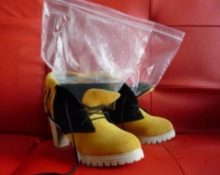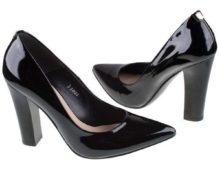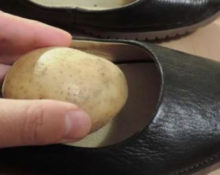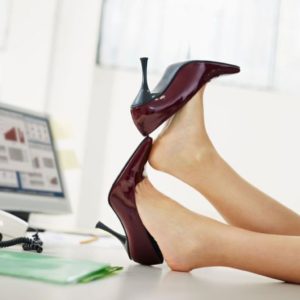 Patent leather shoes are made from natural or artificial leather, treated with special chemicals that give the material a special mirror shine. Women's shoes with a glossy sheen were first seen in the 40s of the 19th century, and since then the technology for processing the top coating has changed and improved significantly. However, it happens that shoes need to be stretched. There are professional methods for this and those that can be used at home.
Patent leather shoes are made from natural or artificial leather, treated with special chemicals that give the material a special mirror shine. Women's shoes with a glossy sheen were first seen in the 40s of the 19th century, and since then the technology for processing the top coating has changed and improved significantly. However, it happens that shoes need to be stretched. There are professional methods for this and those that can be used at home.
Is it possible to stretch patent leather shoes?
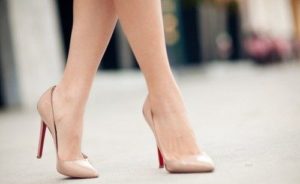
The fact remains unchanged: patent leather is vulnerable and capricious. Unlike conventional leather, lacquer coating:
- “afraid” of sub-zero and too hot air temperatures;
- scratches easily;
- quickly cracks in places where there are creases;
- may “peel off”, become cloudy, change its shade;
- loses elasticity after contact with street dirt and dust;
- ceases to shine due to dampness;
- difficult to stretch.
Taking into account the last of the above points, we can conclude that it is possible to stretch patent leather shoes, however, this must be done extremely carefully and delicately.
It is important to remember that only natural material can be stretched. Shoes made from artificial (even the highest quality) materials will most likely become unusable after attempts to make them comfortable to wear.
In addition, please note that:
- Shoes can only be stretched 2-3 mm in width;
- exclusive and expensive models are best left as they are, due to the impossibility of resuscitating them if something goes wrong;
- If the stretching procedure is successful, the shoes will have to be constantly treated with special care products that prevent shrinkage.
Common mistakes when stretching patent leather shoes

As mentioned, patent leather does not react well to temperatures that are too cold or too hot. Among the many tips on how to stretch boots or pumps that don’t fit, freezing and pouring boiling water are considered the most effective..
Attention! Placing shoes in the freezer and bathing them in boiling water will not solve the problem. With such actions you can get rid of the problem as a whole, but after them there will be nothing left to wear, since the shoes may be completely damaged.
The second most popular bad advice is to hit the rubbing areas with a hammer. Most often they can be found in old magazines, or heard from the older generation. Perhaps in the past, such operations gave positive results, today they will only lead to the fact that shoes can be thrown away.
Another mistake when stretching patent leather shoes is hoping that harsh chemicals applied to the leather on top will soften and stretch it. It is important to remember: the varnish cannot be treated with gasoline, alcohol-containing liquids and silicone. Special stretching agents sold in shoe stores are allowed to be applied to the inner surface of shoes, but not to the outer surface.
Popular Stretching Methods
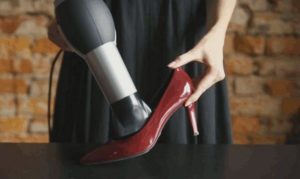
The first thing you can do after discovering that your new and incredibly beautiful shoes are only suitable for sitting at the table in them is to ask a family member whose feet are one size larger to break them in. This method will give positive results in three out of ten cases, it all depends on the shoe model and the density of the material from which it is made.
If larger legs are not found, or attempts do not produce a positive result, ordinary medical alcohol will come to the rescue. As already mentioned, they need to treat the inner surface of the shoe. In this case, alcohol is needed not for stretching, but for softening the hard back or side parts. The legs will act as stretchers, wearing several pairs of socks. After the boots are thoroughly wiped from the inside with a cotton pad soaked in alcohol, they should be worn for 2 to 3 hours. The procedure can be repeated several times.
Important! In people suffering from mycosis of the feet, the slightest contact with alcohol-containing liquids can cause an exacerbation of the disease. In such cases, warm soapy water is used instead of alcohol.
If the first three methods did not bring the desired result, help will come:
- HairdryerThose who decide to try this method should stock up on warm socks and a small amount of hand cream or Vaseline. The hairdryer must be set to the “coldest” setting. The air stream is directed directly into the shoe and warmed up for 5-7 minutes. Afterwards, the problem area is rubbed with cream or Vaseline, and the shoes are immediately put on the sock-clad foot. Remove boots or shoes after they have cooled completely. If traces of cream remain on the inner surface, it can be removed with soapy water or sunflower oil;
- Goose fat. The method that has survived to this day does not lose its relevance today. When our grandmothers bought some kind of shoes in conditions of shortage, it could often turn out that they did not fit them. In such situations, goose fat was used, which was used to lubricate the inner surface of the boots and wait until it was completely absorbed into the material. The fat softened the chafing heels and socks, and the shoes became much more comfortable.
Attention! This method is suitable not only for natural leather. Goose fat also softens “eco” leather with a glossy varnish finish.
The most dangerous stretching method, used when none of the above methods help, is steaming. Using hot steam and boiling water can not only permanently damage shoes, but also leave serious burns on a person’s skin, so you must be extremely careful when handling it:
- to use steam to stretch shoes, take a large pan of boiling water and hold the shoes over it (sole up) for 2-3 minutes;
- Boiling water is poured inside for 2-3 minutes, poured out and the shoes are allowed to dry completely.
To avoid getting burns, it is important to remember to put gloves on your hands and roll back your sleeves.If you follow all the recommendations, you can achieve the desired result, however, do not forget to be careful.
How to stretch patent leather shoes like a pro
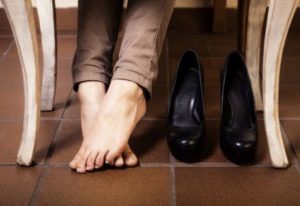
For people who don’t want to risk ruining a brand new pair of shoes by trying to stretch them at home, there are two options to solve the problem: go to a shoe repair shop and purchase a special stretcher.
The first option is the most reliable. Many workshops involved in shoe repair and sewing have special devices that expand shoes in the area of the boot or foot. Equipment of this type will help to correct the instep and adjust the insole to the protruding areas of the foot.
In workshops they don’t just try to stretch shoes to length. This is explained by the fact that the length is determined by the fastening seams, which can be damaged during the stretching process. You can only change the width of leather and leather products. substitute, or stretch chafing backs.
If there are no professional workshops nearby, you can try to make your shoes more comfortable yourself, using special sprays or foams. These products are considered the most effective:
- German spray "VAMA". For a 75 ml bottle of product that can stretch any material, you will have to pay about 500 rubles;
- French "Oke". Softens natural leather, making it more elastic. A 150 ml can of the French product “Oke” costs approximately 650 rubles;
- German aerosol “Stretch” (manufacturer COLLONIL). It has earned many positive reviews, which characterize it as a high-quality means for stretching any type of shoes. The approximate cost of the aerosol is 550 rubles;
- Duke Stretch foam.The Duke Stretch foam produced in Germany is recommended more than others for stretching patent leather shoes. The product has a soft and delicate effect on capricious materials and does not leave any marks when applied to a glossy surface. A 100 ml bottle of foam is relatively inexpensive - 400 rubles;
- Spanish aerosol “TARRSGO”. Recommended for use for different types of materials, however, when working with varnish, it is necessary to use other softening agents. Aerosol “TARRSGO Shoe Stretch” is one of the cheapest imported products, the price for a 100 ml bottle is 300 rubles;
- Domestic "COMPLEX COMFORT SALTON Professional". The stretcher produced in Russia is very cheap (150 rubles per 100 ml), however, after it, the color of the shoe may change and the coating of the shoe may deteriorate.
Several effective methods
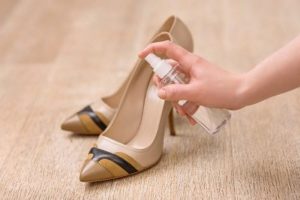
The problem of rubbing shoes is a fairly common problem that every third person faces. You can get rid of discomfort using the following items:
- Old newspapers. Large sheets of newspaper must be cut into small pieces and crumpled. Then the paper is thoroughly soaked with water and the resulting lump of newspaper is tightly compacted inside the shoe. After one or two days have passed and the newspaper has completely dried inside, you can take it out and try on the shoes, which have become much looser;
- Warm towel. A small terry towel is moistened in hot water and wrapped around each of the shoes separately. Then the resulting package is placed in a bag and carefully tied, not forgetting to remove any remaining air for greater tightness. Uncomfortable patent leather shoes should remain in the bag for 8 to 10 hours. After time has passed, you need to take it out and wear it around the house a little, putting it on with thick socks;
- Wet socks. Wet socks are put on bare feet and problematic shoes are put on over them. It is important to ensure that the socks are damp and not soaking wet, as water escaping from the fabric can damage the insole and inner covering. Remove shoes only after the socks are completely dry;
- Stretch pads. You can purchase such a device in specialized stores. Wooden or plastic lasts equipped with a screw mechanism for forceful stretching can slightly expand and stretch the length of the shoe.
If your shoes are tight, it is recommended to use the methods described. They will help correct the situation and solve the problem. The main thing is not to make mistakes and not spoil the varnish coating.


 0
0